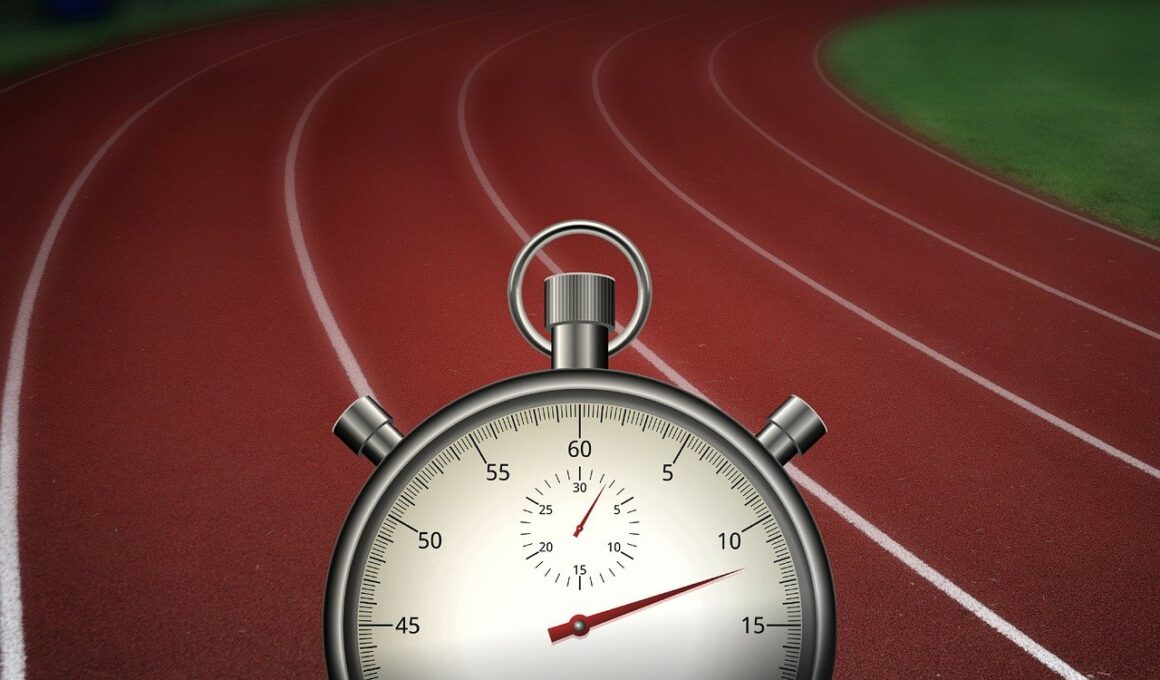Mastering Your Running Form: Key Techniques for Efficiency
When it comes to running, form is crucial for achieving optimal performance and minimizing the risk of injury. A well-structured running form can vastly improve your efficiency, allowing you to run longer distances comfortably. Start by ensuring your head is aligned with your spine, keeping your gaze forward instead of down. This promotes better posture and balance. Your shoulders should remain relaxed and low, reducing tension in your upper body, which contributes to more fluid motion. It’s essential to maintain a slight forward lean from your ankles rather than from your waist. This position engages your core and utilizes gravity to propel you forward, saving energy during long runs. How you position your arms also matters; they should swing naturally in tandem with your legs. This coordination can enhance your overall speed and pace. Lastly, focusing on landing lightly on your midfoot rather than your heel can lessen the shock on your joints while allowing for a quicker turnover. Implementing these key aspects of running form will lead you on the path to becoming a more efficient runner and enjoying the process of running.
Footstrike and Its Importance
The type of footstrike you employ has significant implications for your overall running form, technique, and performance. Generally, runners fall into three categories of footstrike: heel strike, midfoot strike, and forefoot strike. Studies indicate that a midfoot strike is often the most efficient due to its balance between speed and injury prevention. When you land on your midfoot, the impact is distributed more evenly across your foot, reducing strain on your joints. Alternatively, heel striking can promote excessive braking forces, slowing you down and raising the risk of injuries like shin splints or runner’s knee. It’s crucial to find a comfortable footstrike that aligns with your running style and body mechanics. To determine your footstrike, record yourself running on a treadmill. Analyze the footage to see where your foot lands in relation to your body. Adjusting this part of your running form can also enhance your cadence, the number of steps taken per minute. Aiming for a cadence of around 170-180 steps per minute may help maintain an efficient pace without overexerting yourself.
Another critical element of your running form is your stride length, which refers to the distance covered during each step. Many runners often make the mistake of overstriding, causing them to land with their foot too far in front of their body. This misstep can lead to inefficiency and increased risk of injury, as it creates a braking effect. It’s essential to focus on shorter, quicker strides rather than trying to cover more ground with each step. Ideally, strive for your foot to land beneath your hips, promoting a smoother, more fluid running motion. To enhance your stride length appropriately, consider engaging in interval training that encourages quicker leg turnover. Hill workouts are also effective, as they demand powerful muscle engagement and can elevate your overall speed and efficiency. Additionally, strength training is crucial for building the muscles necessary to maintain a proper stride and counteract fatigue. Core exercises, like planks and Russian twists, can enhance stability while running. Implement these techniques in your training routine to foster significant improvements in your running technique and overall enjoyment.
Breathing Techniques for Better Performance
Breathing properly while running is a vital skill that many often overlook. Efficient breathing can help you maintain the stamina required for prolonged runs. Aim to establish a rhythmic breathing pattern that synchronizes with your strides. One common approach is the 2:2 method, where you inhale for two strides and exhale for the next two. This technique can help ensure that your muscles receive adequate oxygen, enhancing endurance during runs. Additionally, practicing diaphragmatic breathing, where you expand your diaphragm instead of your chest, can improve oxygen flow while promoting a relaxed state. Nasal breathing has gained popularity as well, encouraging calmness and reducing anxiety during intense runs. However, if you find that it limits your airflow during high-intensity workouts, alternating between nasal and mouth breathing may be effective. Monitoring your breath while maintaining a relaxed posture can significantly improve your running performance. Regularly incorporating breathing exercises during your training sessions will help reinforce this skill, ensuring that you’re prepared for all running challenges.
Moreover, hydration plays a crucial role in optimizing your running form. Dehydration can lead to fatigue, affecting your ability to maintain the proper technique. Be sure to hydrate well before, during, and after runs to keep your body functioning efficiently. The American Council on Exercise recommends drinking 17-20 ounces of water two to three hours before exercising and 8 ounces during your warm-up. During longer runs exceeding an hour, consider incorporating electrolyte replenishment through sports drinks. After your run, aim to drink roughly 16-24 ounces of water for every pound lost during the activity. Staying properly hydrated supports muscle function and promotes recovery time, enabling you to maintain a consistent running routine. This approach will help you focus on your running form rather than fatigue. Additionally, nutrition plays a significant role in fueling your running. A balanced diet rich in complex carbohydrates, lean proteins, and healthy fats will provide the necessary energy. Paying attention to your hydration and nutrition will help ensure your running form is not only effective but also sustainable.
Strength Training to Support Running Form
Integrating strength training into your routine will profoundly affect your running form and endurance. Building core strength is crucial for stability and maintaining a proper posture while running. Engaging in exercises like squats, lunges, and planks can strengthen the muscles essential for good running form. This development enhances your balance and coordination, helping you avoid injuries as you push your performance to higher levels. Focus on exercises that target your glutes, legs, and core, as they play a vital role in running mechanics. Moreover, developing upper body strength improves your arm swing, which correlates directly with your running speed. A strong upper body supports your form, enabling efficient energy transfer while running. Bodyweight exercises are an excellent entry point, allowing you to gain strength without special equipment. As your strength progresses, consider incorporating resistance bands or weights into your routine. Perform strength workouts two to three times weekly, providing sufficient rest between sessions for recovery. This balance with your regular running will yield substantial improvements in your running form, stability, and overall performance.
Lastly, an essential aspect of refining your running form is consistently evaluating and adjusting your stride rate and pace. Using a running watch or app can help you track your distances and pacing. These tools will enable you to self-analyze your form through metrics such as ground contact time and cadence, improving your overall running form. Consistent monitoring allows you to identify patterns, which can help you pinpoint areas needing adjustment. Experiment with different rhythm choices while maintaining awareness of how it affects your body. If you experience discomfort or fatigue, consider altering your pace until you find a sustainable rhythm. Additionally, practicing running drills can enhance body awareness; for instance, high-knees or butt kicks can improve leg drive and flexibility. These drills are often beneficial for warming up before runs. Furthermore, running with others can inspire motivation and healthy competition, pushing you to refine your form in real-time. By actively managing these techniques and stepping outside your comfort zone, you’ll develop a more efficient running style and boost your enjoyment during each run.
Conclusion: Continuous Improvement
Mastering your running form is no one-time task; it requires continuous assessment and adaptation. As you progress on your running journey, prioritize feedback from your body and external resources like tools or training partners. Reflecting on your running experiences can enhance your understanding of essential form components and identify areas needing improvement. Remember that every runner is unique, and what works for one person may not necessarily apply to another. Focus on personal development by experimenting with different techniques and identifying which ones suit you best. Stay patient throughout this process, as improvements in your running form may take time. Be compassionate towards yourself, acknowledging that even seasoned runners face challenges with form and technique. Participating in workshops or engaging with running groups can provide valuable insight and foster a sense of community. Embrace the learning journey, as it empowers you and enhances your running experience. By consistently refining your running form, you will gain not only efficiency in your performance but also long-term enjoyment from running as a lifelong activity.


